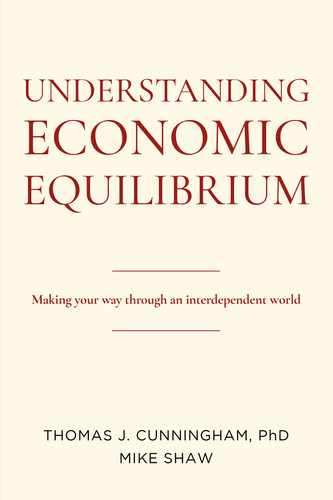This book was a joint effort, in the truest sense of the words, between myself and my coauthor, Tom Cunningham. Throughout our four-year acquaintance I found his ideas inspiring and he found my ability to communicate them a compliment to those ideas. I was delighted when he agreed to my suggestion that we write a book together. We were looking forward to its publication and planned to celebrate the event as one would expect coauthors to do. Unfortunately, on December 27, 2020, Tom died unexpectedly, approximately five months before the book was scheduled to be published. While I am delighted that our book is now available, the occasion of its publication is bittersweet without Tom here to enjoy it with me.
I first met Tom Cunningham in the spring of 2016 at a national banking conference sponsored by a client we shared. I was covering the presentations, writing summaries for a digest the client emailed each year following the conference to about 5,000 bankers. Presenters included senior-level advisors from leading national accounting firms, federal regulators, association officials, and members of the Financial Accounting Standards Board, which had just released a new accounting standard designed to prevent the kind of institutional stress and outright failures generated by the Great Recession.
The conference was in its fifth year and had developed a reputation as substantive and important, especially now that the attendees were going to be responsible for determining their banks’ quarterly reserves based on the new and complicated accounting standard. It was Tom’s first year to speak at the conference, his role as a recently retired Federal Reserve Bank senior economist to provide somewhat of a break from all the accounting speak with a summary view of the status of the U.S. economy. And while the audience was entertained with tidbits like his explanation of economics as “the dismal science,” they were stilled by his understanding of the workings of the world’s economies, insights amassed over thirty years researching macroeconomic realities and developing rationale for U.S. economic policy.
When the conference concluded and speaker ratings were compiled, Tom was the highest rated of the presenters, including two individuals who helped write the new standard. He had captivated his audience with a delivery as entertaining as it was informative, as clear and decipherable as it was insightful. Off stage, following his presentation and at the conference dinners and socials, he was swarmed by attendees with questions from how Brexit would affect the U.S. economy to how the markets would perform in the coming year, why inflation was low, and how baby boomers aging out of the labor force would impact GDP. And no matter how short his drink or cold his dinner, no question went unanswered.
Our mutual client was no dummy. The client knew Tom’s appeal and celebrity with this group of bankers was something to capitalize on more than once a year. Tom and I had become something of conference pals, as well as coconspirators as I was the one committing his spoken words to the written word. And when the client asked him to write a monthly blog, Tom invited me to work with him as his editor. We co-wrote the blog the first Friday morning of each month as the Bureau of Labor Statistics released its employment report until the client sold the business to a consolidator at the end of 2017. The new owners wisely kept Tom and his blog on board, but assigned the editing to their in-house writers.
But I’m no dummy either. I’d been writing about financial issues for financial businesses for more than forty years, long enough to recognize how uniquely Tom connected with audiences, how much he could convey in a few easily digestible sentences, how easy he made it to understand why money makes the world go ‘round.
It was August 2019 and the first time I’d talked with Tom since our client had been acquired. “Hi, Tom. It’s Mike Shaw. Have you ever thought about writing a book?” Of course he hadn’t. With almost weekly speaking engagements and now as chief economist for the Atlanta Chamber of Commerce, when would he find time? Hell, he didn’t even have a website. But the more I pressed the better the idea must have sounded, because I was able to convince him to give it a try.
Getting a business book published starts with writing a proposal that includes sample chapters and a detailed outline and is carefully formatted according to the directions in one of the plethora of books telling you how to write a business book proposal. (Writing a book about how to get published is one of the surest ways to get published.) It took Tom and I almost a year to complete our proposal, but when we submitted it for consideration, it elicited interest, including from the publisher for whom we are now so grateful.
What you will read here is absolutely consistent with how Tom talked to his audiences. He explained in plain language the key ingredients in the global economic soup, simplifying what can be difficult concepts complicated by the intricacies of how they work with and against each other, how they interconnect and interrelate. What’s the difference between real and nominal GDP? How do global financial markets determine the value of a publicly traded U.S. manufacturer? What does it mean to “pay the losers” and why does it make sense? And what is an inverted yield curve actually telling us?
Tom called it the equilibrium principle, and how that unfolds, what it means to our daily economic existences as well as the U.S. and world economies, is what to look for and forward to in these pages.
